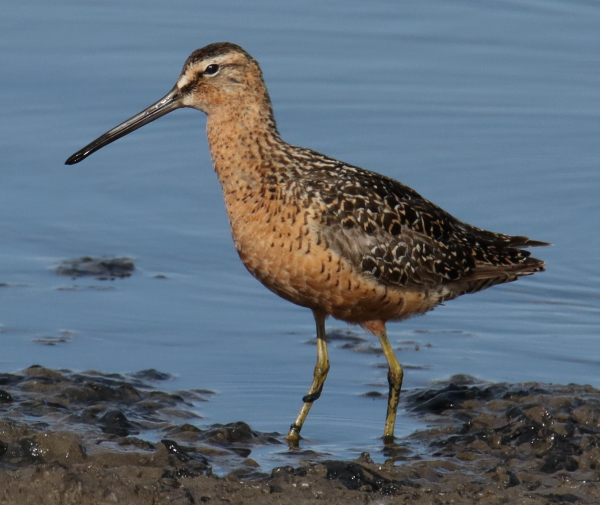
Long-billed Dowitchers are among the 30-plus more common shorebird species counted during the Intermountain West Shorebird Surveys (photo by Paul Konrad).
|
A partnership of more than 300 participants gathered at 200-plus wetland sites across 11 states in the Intermountain West in April, including biologists and birders alike, joined together to survey shorebirds – sandpipers and plovers. Facing inclement weather and an overwhelming sense of urgency to time their efforts during peak migration, the census and water level information collected at each location contributes to a much larger effort, the Intermountain West Shorebird Surveys – and you are invited to participate this fall and next spring.
The Pacific Flyway is a key western migration corridor that a variety of shorebirds use, some migrating across the entire span of the flyway, from the Arctic in North America to Tierra Del Fuego near the tip of South America. Along the way, shallow wetlands and shorelines are essential to shorebirds. Some 30 common shorebird species winter and nest somewhere between the end points of the flyway in North America.
The Intermountain West Shorebird Surveys are already providing some obvious information about the importance of some wetlands. For example, there is evidence that the Great Salt Lake and Salton Sea continue to be 2 of the most important western sites for shorebirds, just as they were 30 years ago, even with varying shorebird counts recorded during recent surveys.
While it was already a massive undertaking 30 years ago, the scope of the project has only increased as more than 50 additional sites are being surveyed today, in addition to the 162 shorebird survey sites. The surveys are conducted through the cooperation of more than 70 organizations including the National Audubon Society and many others. Overall, about 300 people participate, of which 2/3 are volunteering birders; the rest are professional biologists.
Among the 200-plus survey sites, the vast majority are public lands, including more than 40 sites on national wildlife refuges, along with a significant number of lands managed through the wildlife agencies in 11 states. This level of coordination and collaboration is needed due to the massive scale of migrating shorebirds.
It’s really challenging, and inherently there’s very little robust or useful scientific information for wildlife biologists to rely on and use to make land management decisions. Through these surveys they can highlight changes at the species level. Surveyors are also finding that even with changing water conditions, weather-related and otherwise, shorebirds have the innate ability to not only detect habitat but to respond to it and adapt to habitat changes.
If you are interested in participating in this monumental survey, you can learn who to contact, and read much more about the Intermountain West Shorebird Surveys in the original Audubon article at The Monumental Effort to Understand Migrating Shorebirds | Audubon